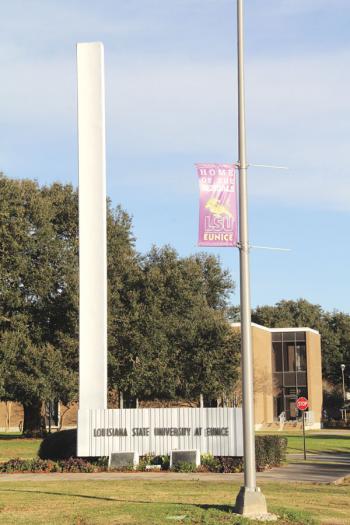LSUE offered as a model for community college to university transfer rates
LSUE and the University of Louisiana Lafayette are named as one of six high-performing pairs of community colleges and universities with strong transfer student outcomes.
LSUE and UL Lafayette were offered as models for transfer practices and policies in a report from the Aspen Institute and the Community College Research Center at Teachers College, Columbia University.
The report, “The Transfer Playbook: Essential Practices for Two- and Four-Year Colleges,” provides a detailed guide for two- and four-year colleges on how to improve bachelor’s degree outcomes for students who start at community colleges.
Josh Wyner, executive director at the Aspen Institute’s College Excellence Program and co-author of the guide, said, “Helping more community college students successfully transfer and earn a bachelor’s degree is both one of the biggest challenges faced by American higher education and one of the most promising strategies for advancing economic opportunity and developing talent in this country.”
Renee Robichaux, LSU Eunice vice chancellor for Academic Affairs, said, “Being featured in the playbook for our 2+2 agreement with ULL highlights the fact that we are committed to helping students succeed while at LSUE, and that we are preparing them to take the next step in their academic careers.”
Every year, millions of students aiming to attain a bachelor’s degree attend community colleges because of their affordability and accessibility, a news release about the report stated.
While the vast majority of students report they want to earn a bachelor’s degree, only 14 percent of degree-seeking students achieve that goal within six years, according to recent research from CCRC, Aspen, and the National Student Clearinghouse. The odds are worse for low-income students, first-generation college students, and students of color — those most likely to start at a community college, the news release stated.
Davis Jenkins, senior researcher at CCRC and co-author of the report, said, “This report presents the evidence-based strategies that community college and university leaders can use to improve outcomes on their own campuses.”
The Transfer Playbook is a practical guide for leaders at community colleges and four-year colleges about the essential, effective practices being used at colleges with strong transfer student outcomes,the news release stated.
Practices cited include:
Leaders at two- and four-year colleges use data to monitor transfer student outcomes, build urgency among faculty and staff for improving transfer student success, and identify areas of improvement in existing transfer practice.
Two- and four-year colleges collaborate to establish and regularly update major-specific program maps so that students, professors, and advisors have greater clarity about university requirements.
Faculty and advisors at community colleges help students choose a major and preferred transfer destination early in their college careers.
Faculty at two- and four-year institutions collaborate to ensure that instruction in lower-division courses at the community college is rigorous and aligned with the expectations of universities to which students are transferring.
Leaders at both two- and four-year institutions make investments in supports that will improve transfer student outcomes and increase the economic returns for students and taxpayers.
The other community college and four-year institutions named are: Front Range Community College and Colorado State University; Manchester Community College and Eastern Connecticut State University; Broward State College and Florida International University and Florida Atlantic University; Holyoke Community College and University of Massachusetts Amherst; and Everett Community College and University of Washington Seattle and Western Washington University.
The report includes the following about the LSUE and UL Lafayette “2+2” education program.
Established in 1999 through the joint efforts of LSU Eunice and UL Lafayette, a “2+2” bachelor’s degree program in elementary education allows students to complete all four years of coursework on the LSU Eunice campus. Each year, the UL Lafayette portion of the program enrolls approximately 20 students, many of whom live in Eunice and have children, which makes the hour-long commute to the UL Lafayette campus more difficult.
The central features of the program are as follows:
• UL Lafayette has specific faculty who teach at the LSU Eunice campus. This way, UL Lafayette faculty have an established presence on the LSU Eunice campus and can tailor their instruction and activities to the LSU Eunice campus context.
• First-year LSU Eunice students map the courses and activities they need to complete their degree—tailored to reflect whether they will commute to Lafayette to complete the program on UL Lafayette’s campus or remain at LSU Eunice for the final two years.
• A UL Lafayette advisor visits the LSU Eunice campus weekly to field students’ questions about their pathway options and to remind students of key milestones they must meet to stay on track, such as taking the PRAXIS certification exams.
• A UL Lafayette math faculty member on the LSU Eunice campus communicates regularly with math faculty on the UL Lafayette campus to ensure continued alignment in math courses.
According to an LSU Eunice administrator, close collaboration between LSU Eunice and UL Lafayette program staff is integral to the success of the program: “The 2+2 program is truly a coordinated effort and one where timing is crucial because the students must be prepared to enter Block I coursework in the fall after completing the Associate of General Studies.”
The guide follows the January 2016 state-by-state report, “Tracking Transfer,” released by CCRC, the Aspen Institute, and the National Student Clearinghouse Research Center, that examined community college student outcomes in nearly every state in the country. Even in states with the best track records, only about one in five community college students transfer and graduate within six years of enrolling. In states at the bottom of the list, transfer and graduation rates are in the single digits.
- Log in to post comments

